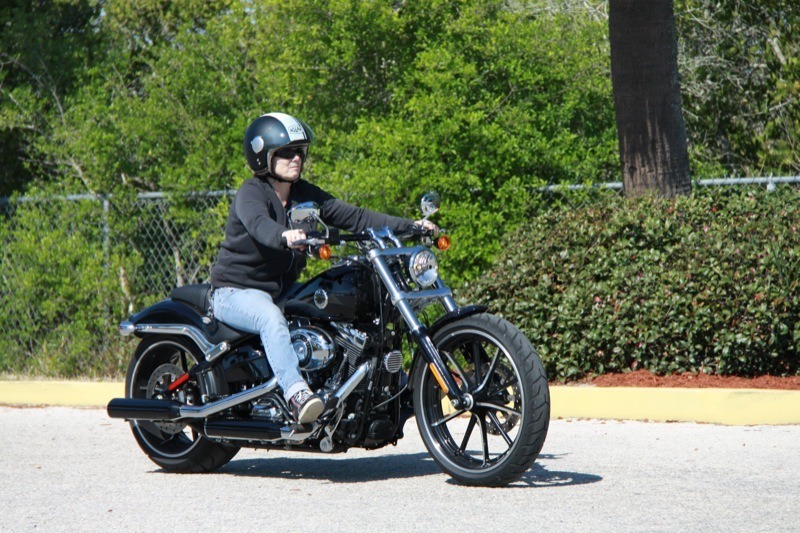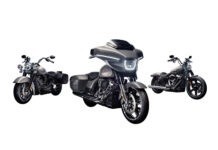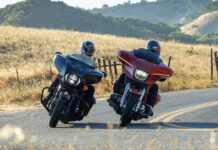I could swear I heard it growling at me. “C’mon. What’re ya waitin’ for? Let’s hit the road, sister!” The Harley-Davidson FXSB Breakout that impatiently sat before me was striking—a serious study in black and chrome. But mostly black.

The Breakout was revealed the first night of Daytona Bike Week 2013, a little more than six months after the introduction of its blingier brother, the 2013 FXSBSE CVO Breakout. The FXSBSE was the first new-model CVO that spawned a new non-CVO model, rather than the other way around. But the Model Year 2013.5 Breakout is most definitely not an afterthought, with the CVO and standard production engineers in collaboration from the get-go. When the CVO Breakout was introduced, Harley-Davidson Styling Manager Kirk Rasmussen explained, “We begin by stripping the bike down to the bones and building up from there.” One could say that the “building up” of the new Breakout stopped short of extravagance, but still includes enough high-end touches to firmly establish it as one of the premium models in the Softail line.
The FXSB shares many of the same features as its CVO precursor, such as the 96.3” length and 67.3” wheelbase, four-piston single-caliper front brake and two-piston floating rear, 5-gallon fuel tank and primary drive, and six-speed gear ratios. On both models, the license plate bracket has been moved to hang off the left rear fender strut, with the turn signals doubling as tail and brake lights. This, in combination with the seriously-chopped low-clearance rear fender that exposes a huge swath of the fat rear tire, gives the Breakout its “I-mean-business” bearing.

There are, however, some major differences. The Breakout is powered by a 103” Twin Cam, as opposed to the 110” powerplant that drives the CVO models. But the compression ratio is a peppy 9.8:1 rather than the CVO’s more civilized 9.2:1. That said, fuel economy suffers a bit with the Breakout, with a 42 mpg rating (the CVO is rated at 45). The Breakout reaches peak power fairly quickly; maximum torque of 95.5 ft/lbs is attained at 3000 rpm, compared to the CVO model that takes 3500 rpm to reach its max torque of 112 ft/lbs (Note that Harley measures power at the crankshaft and not at the rear wheel, so don’t get overly excited by these statistics. Dyno shootout kings should probably knock off at least 20 percent to arrive at more realistic numbers.)
The CVO’s rake is 37 degrees, while the standard Breakout has been reduced to 35, however, the triple tree clamps are angled to kick out the forks two degrees, thereby maintaining the 5.7” trail. Furthermore, the suspension valving was adjusted and the oil tank redesigned to give the rear tire more room to travel. Our Harley contact claims these tweaks were intended to make the Breakout’s handling more manageable.
Cosmetic details are subtle, yet snazzy, with our model’s glossy Vivid Black paint also applied to the new oil tank, fork lowers, handlebar, headlight bucket, brake rotors, and various other parts, complemented by just enough chrome strategically placed on the upper forks, fender struts, air cleaner, exhaust, and other components. The intent of the muted tone is to highlight the drivetrain and the tires, and that effect is achieved nicely.


Exclusive to the Breakout are the gear-shaped, glass-filled emblems on either side of the tank, adding to the visual statement of toughness and power. A low-profile chrome cover tops the tank itself, finished with a black molded leather strip continuing down to the junction of seat and tank. And to carry on the low-profile look, set nearly flush against the handlebar riser is the analog speedometer, which includes push-button digital readouts for odometer, dual tripometer, clock, and fuel range.
The powertrain is powder coated black with chrome covers, and the muffler shields received a gloss black-on-chrome treatment, giving the dual exhaust setup a totally cool and classy look. The exhaust tucks in against the bike nicely, as well, saving your jeans, leathers, or rain gear from burn holes and the pipes from boot scuffs. The low 26” seat also helps, providing most riders with plenty of knee bend while stopped, thereby preventing leg-to-exhaust contact.
Instead of the Mirror Chrome Turbine wheels that come with the CVO, the standard Breakout sports hot-rod inspired Gasser cast aluminum wheels with 10 alternating spokes. The front wheel is wrapped in a 130/60 B21 Dunlop that would have appeared positively skinny when mated with the fat 240/40 R18 rear rubber, except for the hefty 49mm wide front forks—in fact, the widest in the Softail family—that balance the bike’s overall appearance.

Continuing along the sturdy lines of the front end are the stout risers that bring the beefy 1.25” modified drag bars a just a bit closer to the rider. The bike weighs in at 710 pounds wet–18 pounds less than the CVO version. And I could feel those 710 pounds as I lifted it off the kickstand. The upside is that, pulling away from a stop, there’s a solid feel to the front end as the bike moves forward with confidence. Don’t think you can coast through low-speed turns, though; the Breakout needs a steady throttle feed while cornering to encourage that fat rear tire to fall in line with the front. Fortunately, the wide, slightly curved bars help to more easily deliver the pilot’s steering input.
An aggressive riding position completes the slightly sinister, long-and-low stance of this burly bruiser. Although my feet fell naturally onto the forward controls, the bars were a reach for my 5’ 4” frame. The Breakout was tons of fun riding through Daytona Beach, around The Loop and along the Halifax River, but I would probably want to swap out the stock seat and bars with Harley’s Reduced Reach Solo Seat and Reduced Reach or Mini-Ape Handlebar before attempting to ride longer distances. A number of other parts and accessories were released with the introduction of the Breakout, and they include several other seat styles, along with detachable hardware for a sissy bar and luggage rack, leather saddlebags, and the option to swap the Gasser wheels for the Turbine wheels, rotors, and sprocket that come with the CVO Breakout.
During my daytime test ride, the stock seat proved quite comfy, with its tapered front and built-in lumbar support. To my great surprise, the suspension functioned extremely well, dispatching bumps and uneven road surfaces with ease. Although the Breakout’s steering is straight and true and handles curves quite nicely at speed, it’s designed to be a cruiser and not a sportbike; the lean angle of 23.4 on each side combined with the 4.7” ground clearance will cause the foot peg feelers to scrape long before the bike reaches maximum lean.
This bike is not an entry-level model and, as such, is not meant for the new rider, nor is it a canyon carver or a long-haul touring machine. It’s intended to function as a high-end cruiser; a bar hopper to ride and show off around town, or maybe dash between stops on a poker run. To drive home that point, the Harley-Davidson press kit showed the Breakout doing burnouts on the beach. I can’t say I’ve ever seen Harley promote shredding tires in their promotional materials before.
With the exception of the 2013 Heritage Softail Classic Anniversary Edition, the Breakout is the priciest model in the Softail line, although the Heritage Softail Classic and Softail Deluxe aren’t far behind. That said, the Breakout is quite a bit less than the $26,499 sticker price of the CVO Breakout. The MSRP for the Breakout in Vivid Black is $17,899 and colors Big Blue Pearl and Ember Red Sunglo are $18,299. The optional security package that includes Harley’s Smart Security system and ABS costs $1,195.
Harley-Davidson Breakout Ride Impressions: The author’s primal hog lust erupts

by Robert Filla
The first time I ever saw a Big Twin Harley I was 12 years old. It was a Panhead Duo Glide, resplendent in metal flake blue with massive fiberglass saddlebags, a white buddy seat and a windshield as big as a billboard. The second Pan I encountered was a year later in front of a seedy bar. It was all black–partly paint with the balance being grease and grime. A long-distance machine, it sported a solo seat, throw-over leather bags (with what looked like a bullet hole through one) and a set of drag bars. Each of these bikes was captivating in its own special way. The first you’d take ballroom dancing—the second, dirty dancing. And in the spirit of the latter, Harley-Davidson’s new Breakout “standard” model is much more than a watered-down variant of its high-dollar CVO sibling. It captures almost every evil aspect of motorcycling that initially lured me into this two-wheel life.
From its modest 35 degrees of rake (as compared to the CVO Breakout coming in at 37 degrees) to its extra ½” of ground clearance (4.7” over the CVO’s 4.2”), this machine was made to ride, and ride hard. The operator footpegs, shifter and rear brake pedal are well positioned for a take-charge posture. Atop beefy risers are stubby 1.25” diameter drag bars that carry only a hint of curvature, but allow some of the most stable handling this rider has been exposed to in a long time. That bad-boy stance is further accented by the dished-out seat that provides a low 26” seat height. While the distance between the handlebars and the seat pocket offers a macho stance and was comfortable for me, not many riders under six feet will be riding this to Sturgis. But I would.
Being raised on traditional motorcycle suspension systems, I’ve never carried much affection for the Softail configuration. That is until now. And while I’m also not a huge fan of the big tire syndrome, somehow the 130mm x 21” front assembly seems to balance out that huge chunk of 240 x 18” rear rubber making the riding experience more than simply enjoyable, delivering a true hot-rod experience brought home by the ample 103” solid-mount B motor. This “sum of parts” rocks in all the right ways. And although the front end seemed a little heavy at low speeds, I soon discovered the perfect solution to alleviate the problem—go fast!
So keep your ABS brakes, chrome heat shields and keyless ignition. I don’t need the CVO Breakout’s chrome wheels, 110” engine or cruise control, either. Even the simple Vivid Black paint job will suffice. Because this type of bike is the reason I started riding motorcycles in the first place. And with the money I save over the CVO, I can extend that ride to Sturgis all the way to Biketoberfest.




















Where did you find the information about the CVO having a different rake in the neck then the standard Breakout? Also 35 degree neck with 2 degree triple trees will not have the same trail as a neck with 37 degrees, all other components the same. In the case of the Breakout you would have the first with a trail around 5.7 and the second would be over 7.5…… Drastic difference.